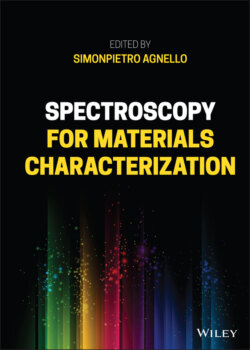Читать книгу Spectroscopy for Materials Characterization - Группа авторов - Страница 20
1.2.5 Excited States Rate Equations
ОглавлениеTo go deeper in the emission features, a simplified Jablonski diagram for the transition processes of electrons among vibronic states can be considered, joining the representations reported in Figure 1.4 (bottom) and Figure 1.6. The singlet energy levels S 0 and S 1 are connected by the absorption process and by the radiative fluorescence emission from S 1 with rate , and the non‐radiative decay with rate . The T 1 state is populated by the intersystem crossing with rate K ISC, and it is connected to the S 0 state by the phosphorescence emission, with rate , and by the non‐radiative process with rate . Under light excitation, it is possible to describe the time‐dependent population of the excited singlet, , and triplet,, states by the rate equations [15, 18]:
(1.104)
(1.105)
where the absorbed light through a sample of thickness L, giving transitions from S 0 to S 1, has been introduced based on Eq. (1.5). It is observed that the emission from the excited states depends on their population; so, it can be stated that for the fluorescence the emitted light is given by
(1.106)
where the excitation, E exc, and the emission, E em, energies have been introduced together with the temperature dependence and a lineshape f(E em) including the homogeneous and inhomogeneous distributions of levels [18]. Analogously, for phosphorescence, it is found that
(1.107)
where the lineshape for the triplet to singlet emission of phosphorescence, g(E em), has been inserted. In the stationary state (ss), it is found that
(1.108)
(1.109)
which can be substituted into (1.106) and (1.107) to obtain
(1.110)
(1.111)
Apart from the dependence on the rate of transitions, these equations show that the emission intensities of both fluorescence and phosphorescence depend on the absorption process. In this context, in the case of low absorption, it is found that (1 – e −αL ) ~ αL. Since the absorption coefficient is a function of the excitation energy, both Eqs. (1.110) and (1.111) enable to determine α(E exc) when the E em is fixed and to reconstruct the absorption profile. This kind of measurement is known as excitation spectrum [2, 18] and enables to determine the connection between the spectra of phosphorescence and fluorescence, relating them to the same absorption pathway, and to reconstruct the Jablonski diagram.
Finally, in analogy to Eq. (1.70), when the excitation light is suddenly removed, Eqs. (1.104) and (1.105) enable to determine the lifetime of fluorescence and of phosphorescence and to demonstrate that they are, respectively [18]:
(1.112)
(1.113)
Considering the temperature dependence of the non‐radiative processes and their rate, these equations show that a lifetime dependence on temperature is present and that at low T the non‐radiative rates are canceled, enabling to evaluate the true radiative rate [18].
